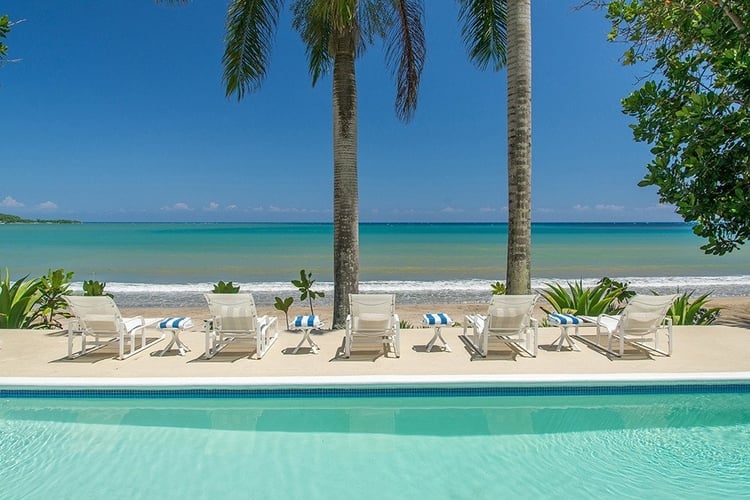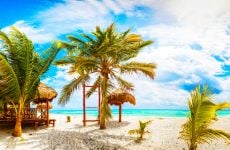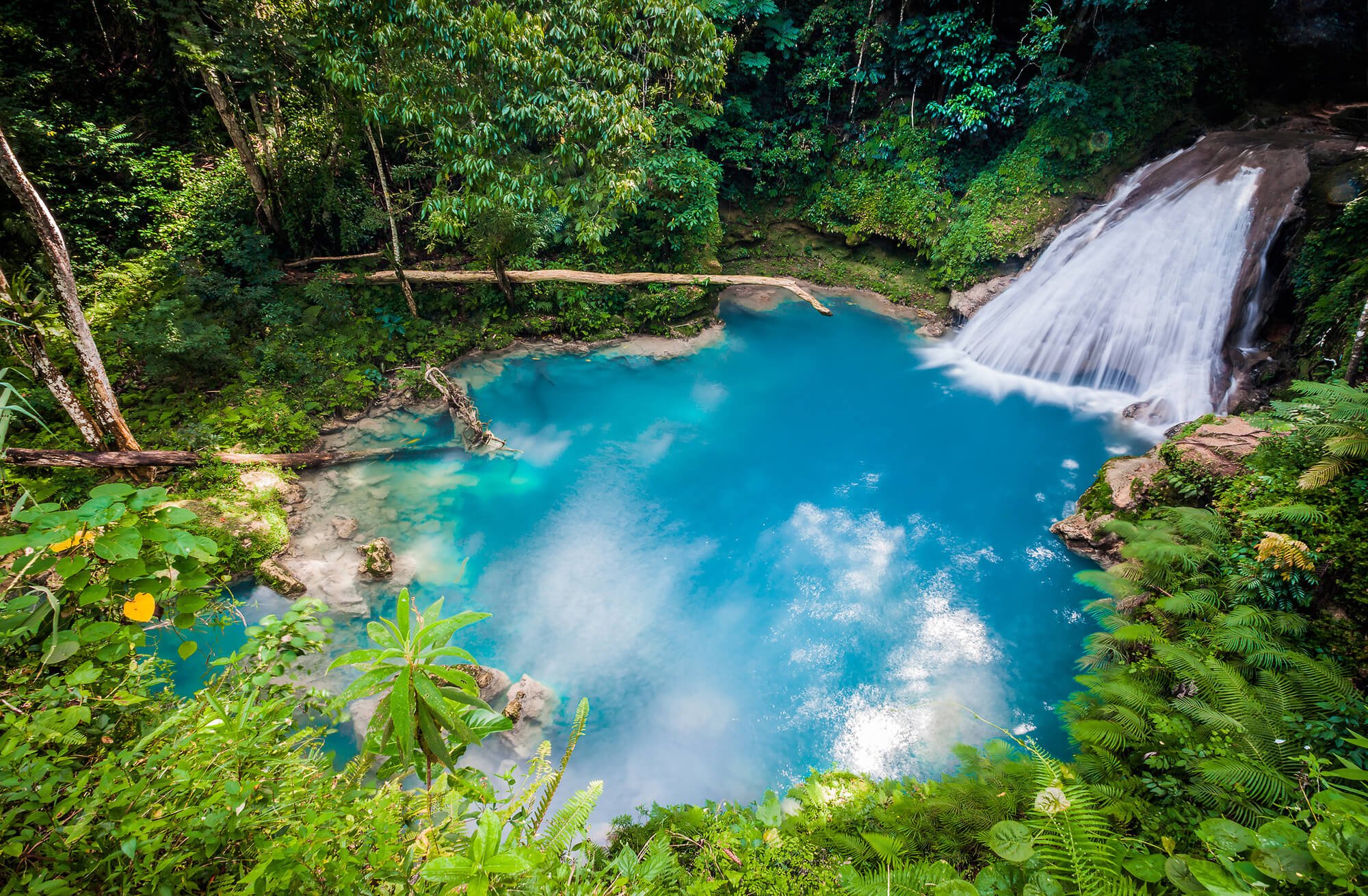Wondering when is the best time to visit Jamaica? With its great beaches and balmy weather, there’s no bad time to visit this vibrant island. Nevertheless, it pays to plan for the weather in advance.
The best time to visit Jamaica will depend on other factors too, like what you want to do, where you want to stay and how much you want to spend. We’ve compiled a simple month-by-month guide to give you an idea of what to expect throughout the year.
After you decide the best time to visit Jamaica for your vacation, take a look at the best places to stay with our selection of villas in Jamaica.

The weather in Jamaica
With average daily temperatures among the highest in the Caribbean, keeping warm is rarely a problem in Jamaica. The winter months are warm and dry, the summer months are hot and humid, and the in-between months are a bit of both! The sea stays warm all year too, so you can comfortably swim or snorkel whenever you go.
The high season in Jamaica is winter, officially that’s between mid-December and mid-April. During these months, you can expect warm sunny days and little in the way of rain. Weather-wise, this is one of the best times to visit Jamaica. Bear in mind that it’s also the peak season for tourism, so the island will be at its busiest during this time. Prices throughout this period will also be at their highest, especially around Christmas, New Year, Spring Break and Easter.
Jamaica has a tropical climate, so you can expect hot sunshine, high humidity and tropical rain showers throughout summer. From June through November, temperatures soar with daily highs reaching around 91F. This low season period is the best time to go to Jamaica for a cheaper and quieter vacation. And while it comes with the risk of rain and storms, there’s usually still plenty of sunshine to go around.

There are a few shoulder seasons too, when you’re likely to get the best of both worlds. The first runs roughly from mid-April through June when vacation prices drop but the weather is still good. For similar reasons, November and the first half of December are good times to go to Jamaica. If you’re confined to traveling during the school summer holidays, note that fares also tend to drop in late August.
When is hurricane season in Jamaica?
Like most Caribbean islands, Jamaica has a hurricane season that officially starts on June 1st and lasts through November 30th. Don’t be alarmed even if you choose to visit at this time; the chances of a hurricane hitting Jamaica during your visit are very slim. In fact, hurricane season can be one of the best times to visit Jamaica, especially in June, July and November. During these months, you will quite often see good weather without any storms.
Note that most storms occur during the autumn months, with storm activity peaking in early to mid-September. If you’re traveling during hurricane season, you should strongly consider buying travel insurance that specifically offers hurricane coverage. Such insurance is easy to get hold of and will protect your investment should a storm prevent you from traveling.
We also recommend checking for weather updates from the USA’s National Hurricane Center before you go.
When is the best time to go to Jamaica?

There is no bad time to go to Jamaica as every season has its own advantages. Visit in July for a roasting-hot beach vacation, or in December for a much-needed winter escape. September and October are the cheapest months to visit Jamaica and still offer sunshine despite the chance of rain. The springtime is a good time too, offering sunny weather and cheaper prices without big crowds of tourists.
Check out our month-by-month guide for a more in-depth look at the best time to visit Jamaica:
January
January is one of the coolest months in Jamaica, but it’s also one of the most popular times to visit. Rainfall levels are low and the island stays warm throughout the month. Average daytime temperatures are in the mid to high 70s (around 25c). There are around 9 hours of sunshine per day and humidity is of little concern as conditions tend to stay airy and pleasant. The sea is warm too, so you can enjoy water-based activities like swimming and snorkeling.
If you’re visiting Jamaica in January be aware that it’s winter for many of those who live in northern climes, so tourists will be flocking to the Caribbean to escape the cold. This high season runs from December until around mid-April, so you should expect higher prices and more crowded facilities, especially around the holidays.
Note that while the days may be long and warm in January, it can become chilly at night, especially in the mountains.
February
You may experience a little rain in February but any showers are usually light and quickly followed by clear sunny skies. The sun shines for a good 9 hours a day throughout the month and the sea is beautifully warm making it ideal for swimming, snorkeling and water sports. February is slightly warmer than January and a busy month for those seeking winter sun, although you can avoid the worst of the crowds if you travel during school time rather than in the UK’s half-term holiday which lasts a week.
February is a great month for getting out and about before the major heat hits. You can explore the beautiful scenery around Montego Bay, visit the famous Dunn’s River waterfall or enjoy a great range of outdoor activities like hiking, biking and horseback riding. The second month is also the time when islanders celebrate the life of Bob Marley who was born and later died in Jamaica. Get down at the Bob Marley Birthday Bash, visit the Bob Marley Museum or pay respects at his burial site in Ocho Rios.

March
With its great combination of low rainfall and warm weather, March is one of the best times to visit Jamaica. You can expect highs in the 80s and bath-like seawater temperatures. Beach days are a good idea in March which boasts an average of 9 hours of sunshine per day. March is also a good month for outdoor pursuits as you’re unlikely to be hampered by any rain.
Be aware that throughout March and into mid-April it’s Spring Break for vacationing college and high school students. So if the idea of partying students doesn’t appeal to you, consider avoiding the main tourist areas..
April
If you’re visiting Jamaica in April you’ll find it less busy than in the preceding months, especially after Easter and Spring Break. The sun shines for a brilliant 10 hours a day during this shoulder season month and daily temperatures are warm but not uncomfortably so. Expect a little more rain as it heads towards the start of the wet season especially around the Blue Mountains.
For families, Easter is a fun time to visit Jamaica with plenty of events around the Easter weekend. If you wait until after Easter to travel though, you’ll be rewarded with lower rates for accommodation as well as far fewer tourists.
May
With peak season weather and low season prices, May is one of the best months to visit Jamaica. The rainy season is still a while away and rainfall levels are relatively low so it’s unlikely that your vacation will be hampered by bad weather.
Each day sees an average of around 10 hours of sunshine so it’s good news for sun-seekers. Peak daytime temperatures hover in the 80s although cooling trade winds help to keep things comfortable. It may be the start of the low season in Jamaica however there are plenty of advantages to traveling at this time including lower fares, quieter facilities and a better chance to appreciate Jamaica’s laid-back way of life.
June
The start of the low season in Jamaica, June brings with it hot and humid weather. Yes, it’s the start of the hurricane season too, although the chances of a serious storm hitting so early in the year are slim. In fact June can be one of the best times to visit weather-wise as daily highs are warming up towards the hottest month of the year – July.
Despite the increasing heat, Jamaica is very pleasant at this time of year with northeasterly trade winds keeping things cool along the coast. Humidity is high through the month, and there are refreshing rain showers in the afternoons and evenings which tend to clear quickly. The ‘hurricane’ tag may put some people off traveling to Jamaica in June, however, the very best attractions remain undiminished – sea, sand, surf, and lots of sunshine.
July
The sun really has his hat on in July with a whopping 11 hours of sunshine each day. July is the hottest month of the year in Jamaica and a busy time for tourism with families flocking in for their summer holidays. Average highs in July are a roasting 84F although even this can creep up even higher. There isn’t much respite from the heat during the evening hours either with temperatures only dipping down to the 70s.
In terms of things to do, the summer months are the best time to visit Jamaica. Some of the island’s best festivals happen in July, including the Reggae Sumfest which takes place every year in Montego Bay. Rain could make an appearance, but any showers are likely to be a welcome break from the heat.
The resorts tend to be busy during the school holidays, so you may want to stay in a private villa instead. Most villas come complete with a private pool as well as in-villa staff who will cater to your every need.

August
August is the height of the summer in Jamaica so be prepared for high heat and humidity. Daytime highs reach into the 90s and sea temperatures are warm too. Great news for beach lovers and water-sports enthusiasts! On the downside, there’s a good chance of rain in August and prices run high during the school holidays.
Entertainment-wise, you will find plenty of exciting events happening in August, including the MoBay Jerk Festival and the Ocho Rios Seafood Festival.
September
If you’re visiting Jamaica in September be aware that it’s the height of the hurricane season. That said, the chances of a serious hurricane affecting your vacation are still statistically low.
If you don’t mind the risk of rain, September can still be a good time to go to Jamaica. This is one of the quietest months of the year, with fewer holidaymakers once the school term starts. Despite the higher rainfall, you’ll still enjoy warm sunny days and gorgeously warms seas. Plus you can use any rainy periods as an opportunity to explore the indoor attractions and duty-free shops.
October
October is the wettest month of the year in Jamaica – you’re likely to see some rain on around half of the days. It could be a downpour that lasts for just a few minutes, or it could be a continual rainfall for a few hours in the evening.
Despite the rain, October can still be a good time to visit Jamaica as the showers mostly leave behind clear sunny skies. It’s still the low season so you’ll find some great deals, however prices usually creep up during the UK’s half term week.
November
November marks the second shoulder season of the year and is a fantastic time to travel to Jamaica. The hurricane season is coming to an end and the rainy season begins to taper off in this quiet, cooler and cheaper month. Even as it heads towards winter, there are a good 8 hours of sunshine a day with temperatures hovering in the high 70s. Some travellers consider this in-between month to be one of the best times to visit Jamaica.
November is a great time for a getaway before the Christmas crowds arrive. You can take advantage of the duty-free shopping malls and stock up on Christmas gifts ahead of time. The Crafts Market in Montego Bay is a great place to buy handmade souvenirs, or you can head to the Shoppes at Rose Hall for a more mainstream shopping experience.
December
The start of high season, December is an exciting time to go to Jamaica. Christmas is on the horizon and school is out at the end of the month, so there are some fantastic vacation options to choose from. Visit in early December and you’ll get great weather and lower prices than in the holidays. Go later in the month and you’ll get to spend Christmas on the beach.
December falls outside of the hurricane season so there are no worries in that regard. Daytime temperatures in December hover in the 70s making it a great time to go if you want pleasant conditions, as opposed to the oppressive heat of summer.
Look out for the many fun and colorful events taking place all across the island. Whether you want to celebrate in a local church, kick back on the beach or party the night away in Montego Bay, you’re sure to find plenty to do.



